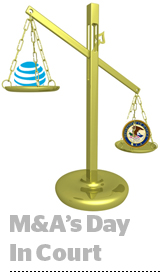 The Washington DC, District Court on Tuesday gave the go-ahead for AT&T’s $85 billion merger with Time Warner, a decision with far-reaching implications for AT&T and the media and advertising industries.
The Washington DC, District Court on Tuesday gave the go-ahead for AT&T’s $85 billion merger with Time Warner, a decision with far-reaching implications for AT&T and the media and advertising industries.
Despite the hefty price tag, industry observers initially expected AT&T’s offer to breeze through under a corporate-friendly administration. The last time the Justice Department blocked a vertical merger of two companies from different parts of the same supply chain was in 1972 when Ford Motors tried to acquire one of only two US spark plug manufacturers.
The DOJ argued AT&T would be incentivized to raise prices for Time Warner content and consumer subscriptions after the deal, but the two companies said the merger is more about right-sizing to compete with online technology, as opposed to muscling out legacy multichannel video programming distributors (aka telcos).
With Time Warner content in its arsenal, AT&T’s nascent ad platform would help supplant lost cord-cutter business and thus keep down subscription prices, AT&T CEO Randall Stephenson said during the trial.
“If you miss one technology cycle, it may not kill you, but it will make you sick for a very long time,” Stephenson said, alluding to how companies such as Netflix, Amazon and Google are running away with market-share growth.
Time Warner CEO Jeff Bewkes testified in April that online video streaming platforms had hit the media giant with a “double whammy” by pulling ads online and subscribers out of cable TV bundles.
For AT&T, Time Warner was well worth the wait and hassle – though the case may not yet be over, considering the DOJ may appeal the decision to the Supreme Court.
AT&T’s Advertising and Analytics group, which the company has been assembling since it hired GroupM’s Brian Lesser last August, is built on a three-legged stool of data, distribution and content, but it hasn’t actually had the content in place to support the product.
Having Time Warner’s Turner television assets, including CNN, TBS and Turner Sports, “is of paramount importance in terms of building the platform,” Lesser said in January at AdExchanger’s Industry Preview.
Now Lesser and the ad tech team he’s assembled can put plans in motion.
Lesser positioned the AT&T platform as an alternative to reach addressable audiences at scale without wading through murky video content on YouTube and Facebook. Consumers are bludgeoned by performance advertising online and brands can’t rely on quality content, he said, but “what better canvas to fix that than a marketplace with only professionally produced content?”
This post was syndicated from Ad Exchanger.

More Stories
Warner Bros. Discovery CEO David Zaslav Receives $51.9 Million Pay Package for 2024
TikTok Fave Duolingo Boosts YouTube Shorts Viewership 430% in One Year
Streaming Ratings, Week of March 10: Disney+ Sails to the Top Courtesy of Moana 2